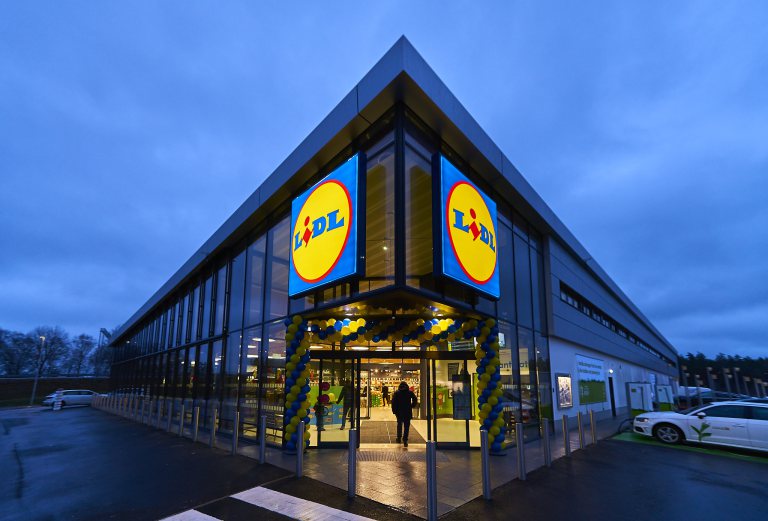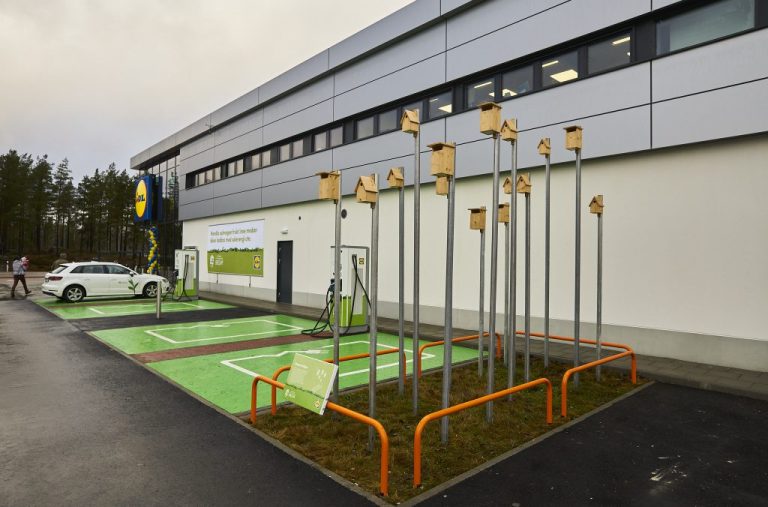Reinforcing a brand through sustainability
After establishing their business in Sweden, Lidl has been actively working to strengthen their brand, and a part of this work is to develop sustainable solutions.
Lidl started in Sweden in 2003 and had to make changes in order to adapt to the Swedish market. But today, Lidl has not only adapted, it is a leader in the industry and a major player in sustainability, even though many don’t understand how low cost and sustainability work together.
A project that really highlights how hard Lidl has worked with environmental and sustainability issues is the new store in Växjö. BREEAM-SE played an important role in the development of Lidl’s new store concept, including in terms of energy use and the green areas in and around the building.
In the parking lot there are charging posts for electric cars, charging poles for electric bicycles and a bicycle pump. Inside the shop there are displays about public transport, so customers can keep an eye on when the next bus runs. Lidl is not only sustainable in itself, but also encourages its customers to be.
On the store roof there are solar cells that cover about 30% of the store’s energy needs. It is estimated that no heating energy is required from outside because of the solar cells and the heat from the refrigerators. Additionally, different eco-zones have been built to suit different species, signs have been set up that visualise and explain to the public what the different eco-zones mean. For example, the eco-zone 'Holken' is adapted for birds, and on the roof an area for plants to grow. Everything has been planned to preserve the biodiversity in the area and even bring more.
In addition to all the environmental and sustainability benefits of certifying a building, environmental certification also strengthens the brand – both externally to real estate companies, tenants, municipalities and other stakeholders, but also internally for employees.
It is also felt that there has been increased curiosity for what Lidl has achieved in sustainability issues and for the skills now available in the extensive work on a new store concept. Lidl’s energy consumption is roughly half of the industry segment, due to the fact that their buildings are compact, take on heat from refrigerated ice cages, have smart ventilation and reduce resource consumption.
In the future, the ambition of the brand is to certify all the stores that they own against BREEAM.
This article was originally published here by BRE Buzz on 24 April 2018. It was written by BREEAM-SE.
--BRE Buzz
[edit] Find out more
[edit] Related articles on Designing Buildings Wiki
Featured articles and news
Latest Build UK Building Safety Regime explainer published
Key elements in one short, now updated document.
UKGBC launch the UK Climate Resilience Roadmap
First guidance of its kind on direct climate impacts for the built environment and how it can adapt.
CLC Health, Safety and Wellbeing Strategy 2025
Launched by the Minister for Industry to look at fatalities on site, improving mental health and other issues.
One of the most impressive Victorian architects. Book review.
Common Assessment Standard now with building safety
New CAS update now includes mandatory building safety questions.
RTPI leader to become new CIOB Chief Executive Officer
Dr Victoria Hills MRTPI, FICE to take over after Caroline Gumble’s departure.
Social and affordable housing, a long term plan for delivery
The “Delivering a Decade of Renewal for Social and Affordable Housing” strategy sets out future path.
A change to adoptive architecture
Effects of global weather warming on architectural detailing, material choice and human interaction.
The proposed publicly owned and backed subsidiary of Homes England, to facilitate new homes.
How big is the problem and what can we do to mitigate the effects?
Overheating guidance and tools for building designers
A number of cool guides to help with the heat.
The UK's Modern Industrial Strategy: A 10 year plan
Previous consultation criticism, current key elements and general support with some persisting reservations.
Building Safety Regulator reforms
New roles, new staff and a new fast track service pave the way for a single construction regulator.
Architectural Technologist CPDs and Communications
CIAT CPD… and how you can do it!
Cooling centres and cool spaces
Managing extreme heat in cities by directing the public to places for heat stress relief and water sources.
Winter gardens: A brief history and warm variations
Extending the season with glass in different forms and terms.
Restoring Great Yarmouth's Winter Gardens
Transforming one of the least sustainable constructions imaginable.

























